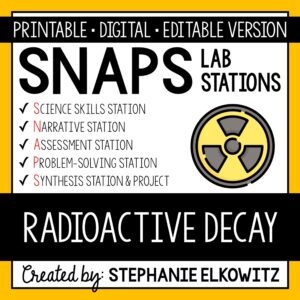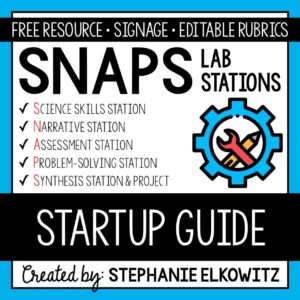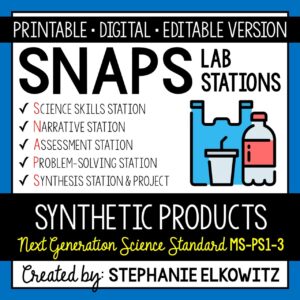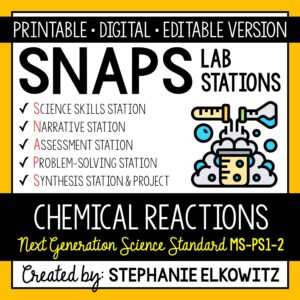MS-ESS3-3 Water Pollution Lab
$7.00
An engaging lab activity designed to enhance students’ understanding of water pollution and help students apply scientific ideas to the real world. Aligned with NGSS MS-ESS3-3.
Description
MS-ESS3-3 Water Pollution Lab Preview
SNAPs Lab Stations Activities require students to use science, math, literacy, problem-solving and engineering skills. They are designed to enhance students’ understanding of scientific concepts and help students apply scientific ideas to the real world. Each station activity promotes skills so to develop students into proficient and competent scientific thinkers.
SNAPs lab activities have five components:
• Science Skills Station to develop science skill proficiency
• Narrative Station to build science literacy
• Assessment Station to evaluate learning and understanding
• Problem-Solving Station to foster engineering design
• Synthesis Station and Project to inspire higher-order learning
DIGITAL LABORATORY – DISTANCE LEARNING & DIGITAL CLASSROOMS
• This lab is offered in a digital format to support digital classrooms & distance learning.
• The digital lab activity is designed to work with Google Slides and Microsoft PowerPoint
• The digital lab activity CANNOT be edited. However:
– Students can manipulate text boxes
– Students can create tables, graphs and diagrams
– Students can insert images and drawings
GOOGLE FORM ASSESSMENT STATION
• The assessment station is offered as a self-grading Google Form.
• Questions are all short answer and are 100% editable.
• Suggestions for use are included in the download.
DISTANCE LEARNING COMPATIBILITY
SNAPs lab activities are rated for their ease with distance – independent learning. Refer to the preview for more information about how well this laboratory works in a fully digital classroom and with distance learning.
EDITABLE DOCUMENTS
This download includes an editable word document (docx file) of all lab components:
• Pre-Lab and Post-Lab Activities
• The Lab Overview
• Lab Station Activities and Questions
• Directed Synthesis Project (when applicable)
Important Notes:
• Diagrams, illustrations, tables and graphs essential to lab activities are included
• Illustrative clipart is NOT included
• Editable documents and rubrics are included with the FREE SNAPs Setup Guide
Editable files allow you to:
• Edit the scope of the activities so to suit your students’ needs
• Edit the materials required based on resource availability
• Create single-period “mini-labs” using activities at the individual skills stations
The activities at each station in this lab are detailed below.
Water Pollution Lab Stations Activity Learning Objectives:
1. Identify sources of water pollution.
2. Evaluate harm to living things caused by water pollution.
3. Assess the practicality, cost and effectiveness of methods and tools that help us reduce water pollution.
Science Skills Station
Students will study and graph the water pollution in the Chesapeake Bay to better understand the sources of pollutants that create “dead zones” in the water. Students will also study how thermal pollution impacts dissolved oxygen and the survival of aquatic organisms.
Narrative Station
Students will read an informational text about water pollution and three major sources of water pollution. Students will also read about the importance of water treatment and how people are affected by water-related diseases when water treatment is not in place.
Assessment Station
At this station, students will answer questions about key terms and ideas relating to water pollution. Students must employ lower, mid and higher order thinking skills to answer these questions.
Problem-Solving Station
Students will design, build and test a water filter so to clean dirty water. Students will have the opportunity to improve the design of their water filter once.
Synthesis Station
Students will compose a CER (claim-evidence-reasoning) report to summarize the lab. Students are provided the claim statement and must support the claim with observations, data and other information gathered in the lab. Students will explain how the evidence supports the claim using scientific reasoning.
Synthesis Project
Students will have a choice of 11 projects. Refer to the SNAPs Lab Stations Best Practices and Setup Guide for directions and suggestions on how to conduct the project.
This download includes:
• A pre-lab assignment and post-lab reflection
• Directions and questions for each lab station
• Student recording sheets
• Teacher Key
Additional Materials Required:
Empty 500 mL plastic water bottles, caps removed (2 per lab team)
2 glass or clear plastic 8 oz measuring cups (with printed measurements)
Various materials to construct a water filter: cheesecloth or gauze, tulle, facial tissues, paper towels, coffee filters, cotton balls, clean sand, aquarium gravel
1 gallon of polluted water (for every 8 labs groups): white vinegar, dust, hair (human and/or pet), dirt, yellow food coloring, water
pH paper (optional)
NEXT GENERATION SCIENCE STANDARDS
This laboratory satisfies NGSS MS-ESS3-3. It combines the three dimensions of science learning – science and engineering practices, disciplinary core ideas and crosscutting concepts – to meet the standard. This lab also makes interdisciplinary connections to STEM, Math CCSS and ELA CCSS to build the appropriate skills.
TERMS OF USE
• All rights reserved by Stephanie Elkowitz.
• This product is to be used by the original purchaser only.
• Intended for classroom and personal use only.
• Copying for more than one teacher, classroom, department, school, or school system is prohibited.
• This product may not be distributed or displayed digitally for public view.
• Failure to comply is a copyright infringement and a violation of the Digital Millennium Copyright Act (DMCA).








